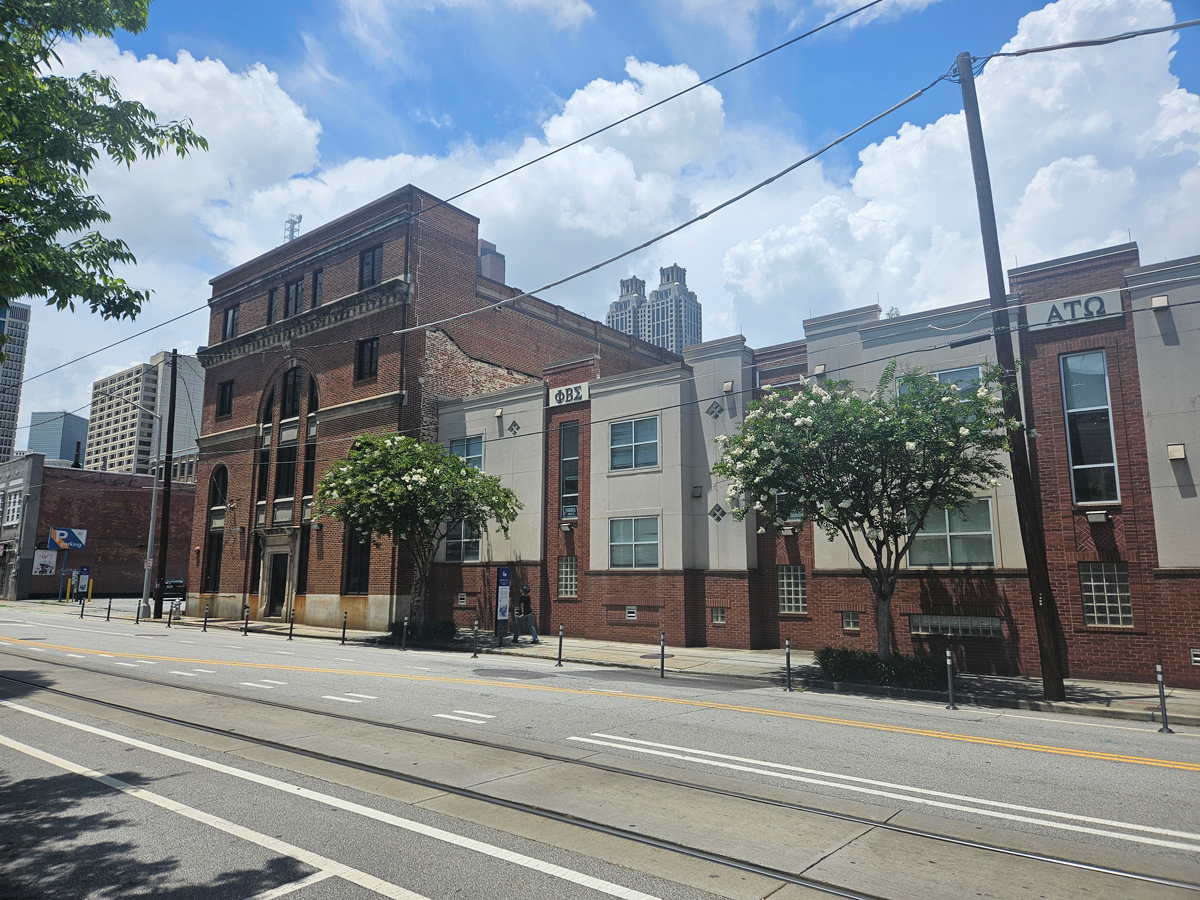{Photograph} by Sean Keenan
Since 1913, Georgia State College has been embedded within the coronary heart of Atlanta—its campus stitched into downtown’s streetscape. Now, GSU needs to reimagine that patchwork as a real “school city.”
A small military of intown historians and activists finds part of that plan problematic.
The college’s overarching mission: make Georgia State’s central campus extra walkable, welcoming, and, most significantly, safer. The $100-plus million plan—anticipated to be full earlier than 2026’s FIFA World Cup—calls to raze the Sparks Corridor classroom constructing and shut off a part of Gilmer Avenue to make method for the 15-acre “Panther Quad,” increasing GSU’s new Greenway hall that weaves via downtown’s grid system. It might additionally retrofit some getting old buildings to provide state-of-the-art lecture rooms.
However blueprints for open, pedestrian-friendly areas additionally name for the demolition of a century-old constructing at 148 Edgewood Avenue. Its destruction, authorized by Governor Brian Kemp, would liberate house for a pint-sized park for the varsity’s fraternities and sororities.

Rendering courtesy of Georgia State
Don’t you dare, says the vociferous opposition motion composed of historic preservationists, group teams, neighbors, and Liliana Bakhtiari, the Atlanta Metropolis Councilmember who represents the district. Most of the identical voices stopped the wrecking ball from taking Georgia State’s outdated Bell Constructing—it’s quickly to reopen as the house of the Nationwide Institute for Scholar Success—they usually assume they’ll do it once more.
Leveling the circa-1916 construction—which housed the Georgia Railway and Energy Firm lengthy earlier than the one-time streetcar operator advanced into the statewide utility Georgia Energy—can be an affront to Martin Luther King Jr.’s legacy, opponents say; they argue it will throw a center finger at a nationwide historic district bearing the late civil rights icon’s title that’s already watched roughly half its buildings vanish over time within the pursuit of financial growth.
“This constructing can be one other sufferer to the dearth of foresight and of understanding the distinctive worth an city campus can present,” David Mitchell, the top of the nonprofit Atlanta Preservation Heart, mentioned in an interview. “It’s one thing that has survived within the final 100 years of Atlanta, a metropolis that has advanced dramatically. It’s been a witness to the complete expertise of twentieth Century Atlanta.”
Chad Keller, the director of GSU’s Heritage Preservation Program added: “Whereas nothing of specific historic notice occurred at 148 Edgewood, it does have historic worth because it pertains to its design, craftsmanship, and building.”
LeJuano Varnell, government director of historic preservation and group revitalization nonprofit Candy Auburn Works, echoed these considerations in a September 2024 letter to GSU President Brian Blake, reminding the varsity’s chief government that the establishment had as soon as advocated 148 Edgewood’s preservation and renovation.
Efforts to guard the constructing have spanned a long time, together with its inclusion in state and nationwide historic districts in 1989 and 1992, faculty preservation plans from as latest as 2021, and a 2024 state willpower that demolition would “have a ‘vital affect on historic properties,” Varnell wrote.
Certainly, the State of Georgia’s historic-preservation arm final 12 months instructed Terracon Consultants, GSU’s contractor for the redevelopment, that razing 148 Edgewood may harm neighboring properties’ eligibility for state and federal protections.
“The demolition of an individually eligible property and unknown new building that’s doubtlessly incompatible with historic properties within the venture’s [area of potential impact] will not be in line with the State of Georgia’s Requirements for the Therapy of Historic Properties,” Jennifer Flood, a deputy state historic preservation officer, mentioned in an electronic mail obtained by Atlanta.

{Photograph} by Sean Keenan
Nonetheless, Georgia State believes changing the outdated constructing with a Greek-life greenspace gained’t simply make the varsity extra engaging to potential college students; it’ll curb crime and, as GSU chief working officer L. Jared Abramson put it, “unsavory behaviors.”
“Being in downtown Atlanta gives our college students so many wonderful alternatives for experiential studying and networking and profession placement—the main advantages of being in an city atmosphere,” he instructed Atlanta. “However the unsavory behaviors, the smells and conditions that our group members might be confronted with downtown can actually current challenges and distractions.”
College students, Abramson mentioned, made “loud and clear” that they need a “extra walkable campus” and “an atmosphere the place they’ll really feel secure.” There’s “security in numbers,” he reasoned—one thing fostered greatest by creating new gathering areas, just like the one deliberate for 148 Edgewood.
What’s extra, Abramson added, it will be prohibitively costly to retrofit the outdated constructing for college makes use of—some $12 million to open up lower than 9,000 sq. ft for college kids. Plus, he mentioned, GSU already has a strong observe file of fixing up and utilizing outdated buildings; simply have a look at the Bell Constructing.
Kameron Wells, a latest Georgia State grad and member of a traditionally Black fraternity, backs the Greek-life park venture. Throughout a heated public assembly final month at Centennial Corridor—a college constructing a block away from 148 Edgewood—he reminded attendees that “MLK was a member of Alpha Phi Alpha Fraternity, Inc. Is that not honoring his legacy, constructing one thing so monumental like this?”
“We wish a spot to showcase our tradition,” Wells mentioned. “That is going to draw extra college students to need to come to Georgia State, so why wouldn’t we do this?”
Properly, possibly do it elsewhere, recommended Keller, GSU’s prime historic preservation knowledgeable.
“There are sufficient vacant heaps round campus that tearing down a historic constructing shouldn’t be needed,” he mentioned. “GSU can do each, and it shouldn’t be an either-or.”
Commercial

